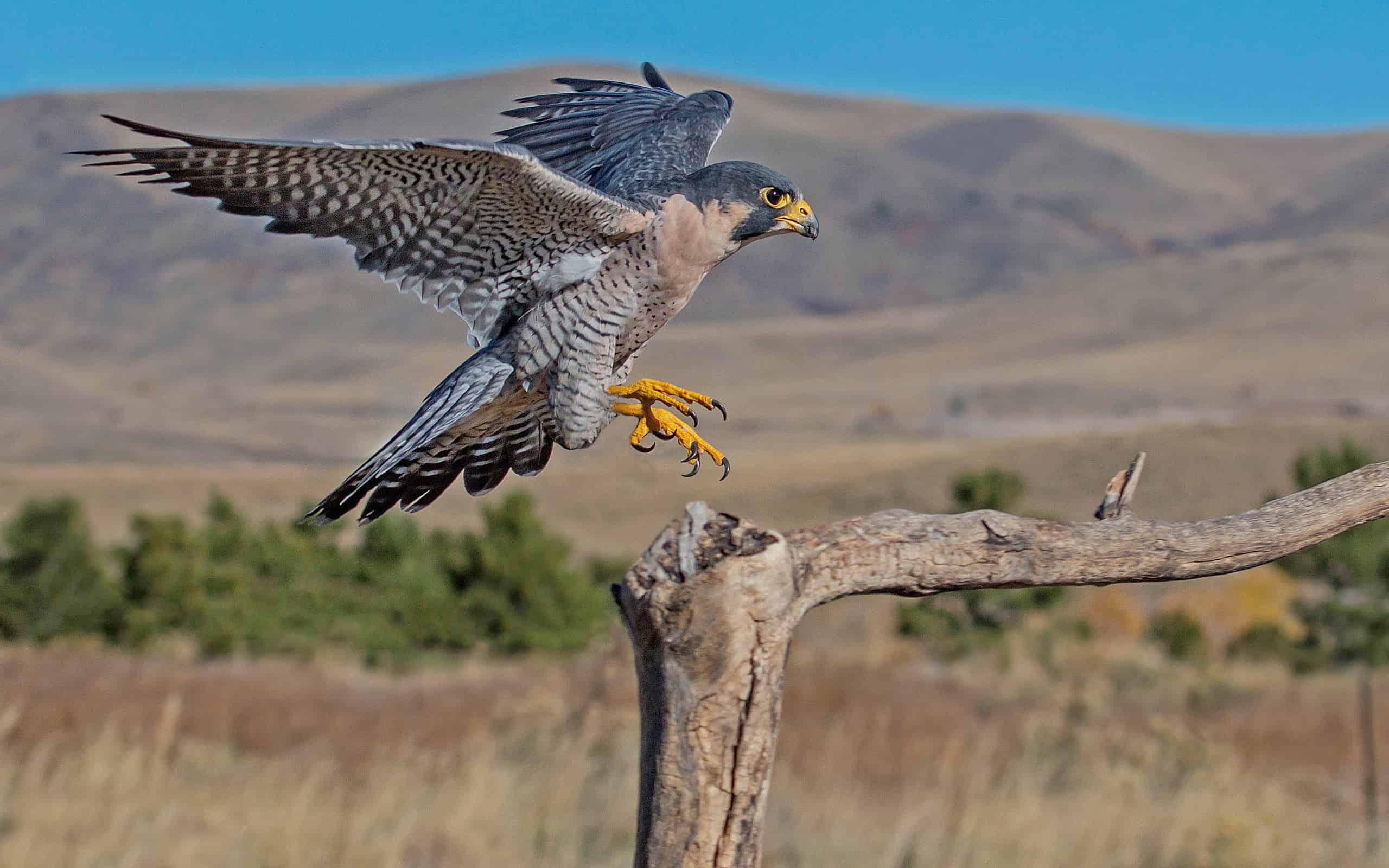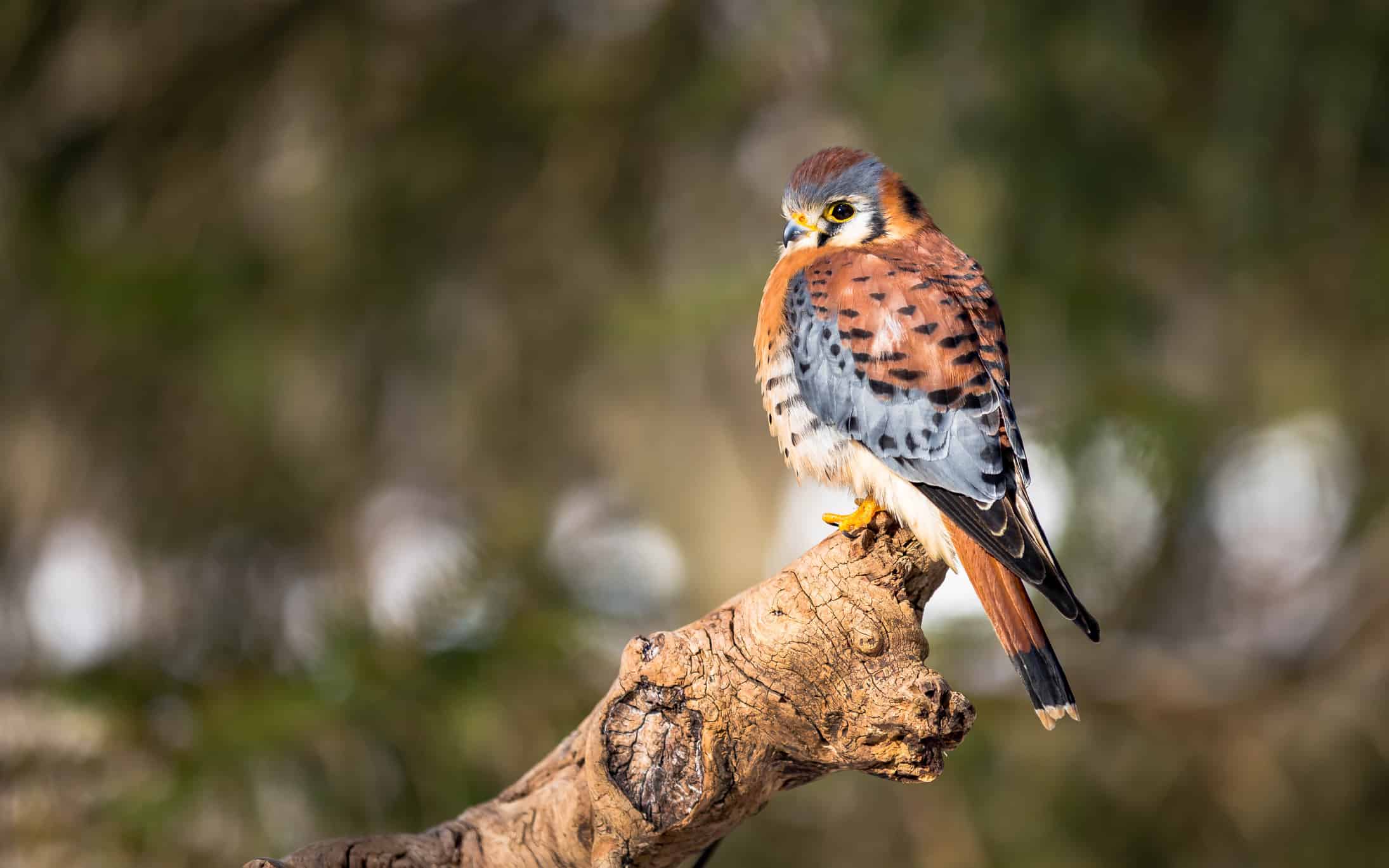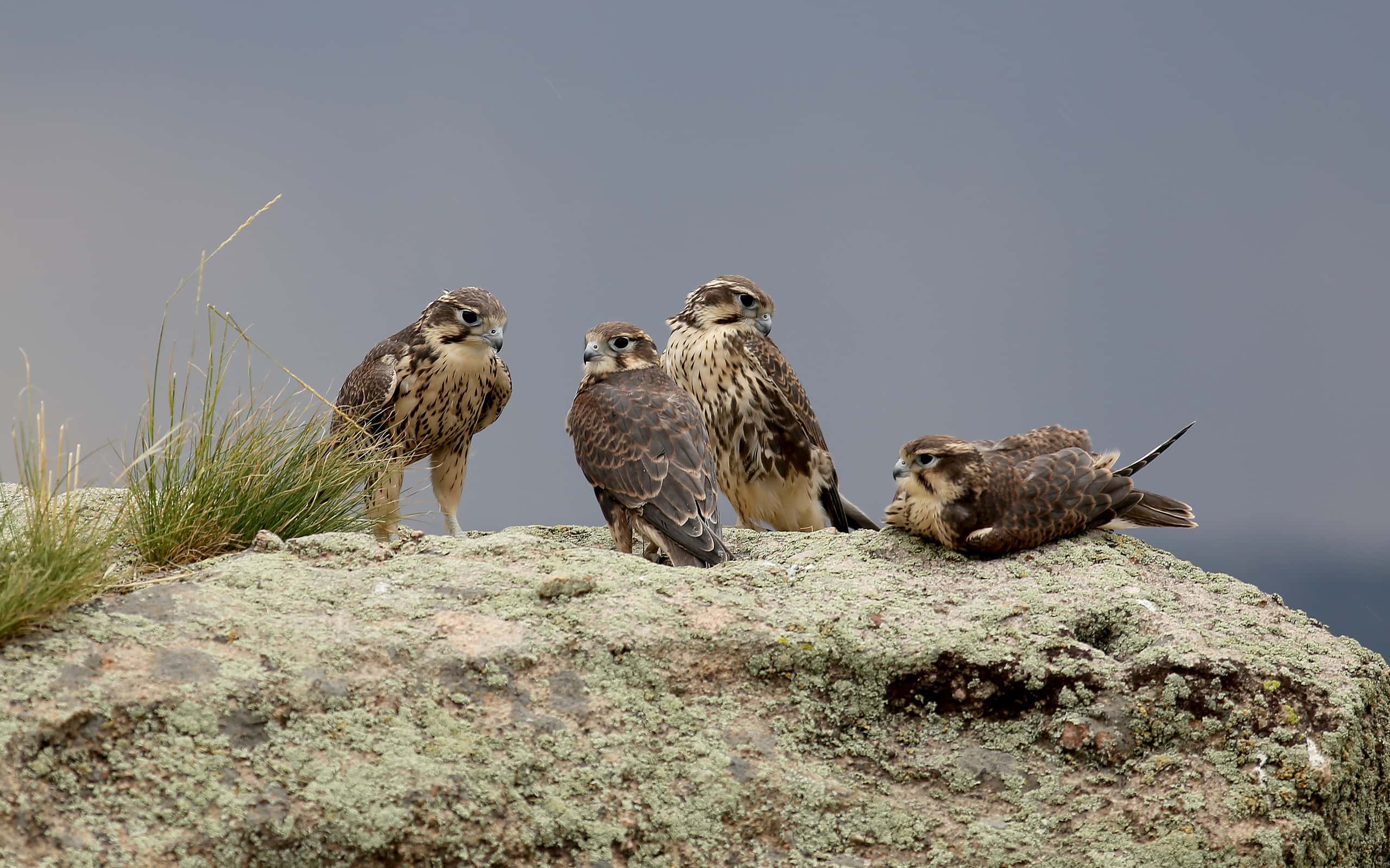The picturesque southwestern U.S. state of Arizona is known for two significant things: the Grand Canyon and diverse wildlife. Thoughts of the Copper State send visions of everything from desert landscapes and rocky cliffs to rattlesnakes, javelinas, and Gila monsters to the forefront of our imaginations. However, when thinking of our feathered friends in Arizona, the unusual desert bird, the roadrunner — once best known for its battles with the coyote on Saturday morning — comes to mind. However, there are many species of various desert-dwelling birds, including six types of falcons in Arizona, and some pretty distinct ways to identify them and their locations.
Peregrine Falcon

A
Peregrine Falcon
is landing on a branch with wings extended.
©DawnKey/iStock via Getty Images
Found everywhere in Arizona, the Peregrine falcon is the most commonly spotted in the state. Finding where they live is often relatively simple, as these majestic birds have a penchant for city life. Peregrine falcons tend to make homes on the sides of tall buildings, meaning they are easy to see, and many people even recognize some of them as celebrities!
These falcons are most commonly located in Arizona and further south into Mexico. However, they can be found on every single continent other than Antarctica. Amazingly, the Peregrine falcon is the fastest animal on planet Earth. These creatures can reach a diving speed of more than 190 mph (300 km/h)!
Identify Peregrine Falcons in Arizona
Like most species of falcons on this list, female Peregrine falcons are larger than their male counterparts. However, there is very little difference in their appearances. Most notably, males and females may have faint barring over slate gray/bluish-black backs and wings. Their breasts are typically white or tan with distinct thin dark lines, although younger Peregrine falcons are generally much browner.
The average Peregrine falcon is 15-20 inches tall with a wingspan of 38-44 inches. Adults are known to have a unique dark hood and the appearance of “side-burns” that run down from their eyes.
American Kestrel

The American Kestrel is one of the smallest falcons in the world.
©emranashraf/iStock via Getty Images
While the American Kestrel can be found throughout most of the United States, there is, perhaps, no place where they are a more common sight than Arizona. Due to having an incredibly diverse diet that includes insects, small rodents, and other birds, the American Kestrel can inhabit many areas. These falcons can be found nearly anywhere from the southernmost tip of South America up to central Alaska. However, spotting them can be difficult as they are the smallest falcons in Arizona.
Also known as “sparrow hawks,” the American Kestrel gets the nickname from often being seen catching sparrows out of the sky. Interestingly, these falcons are relatively comfortable around humans. They are happy to thrive in trees all across many habitats, including deserts, meadows, grasslands, parks, and pastures.
Identify the American Kestrel
Smaller in stature, the American Kestrel is, on average, 9-12 inches long with a 20-24 inch wingspan. Unlike Peregrine falcons, male and female American Kestrel falcons vary in color. Females tend to have rusty-colored wings and back with brownish barring. They typically have buff or tan bellies with brown streaks. Males, on the other hand, have grey or blue wings with white bellies. However, they have rusty colored backs with black bars often along their lower half. Both males and females have white heads with bluish/gray caps.
Prairie Falcon

A family of Prairie Falcons gather on a rocky cliff.
©dbdurden/iStock via Getty Images
Prairie falcons can be spotted all over the state of Arizona. Specifically, these majestic raptors are typically found in shrubby deserts, grasslands, pastures, and farm fields. Be sure to realize that there will be far fewer Prairie falcons if there are too many trees. Outside of the Grand Canyon State, you can find these birds of prey nearly anywhere in the western half of the U.S. and into parts of Mexico and Canada.
How to Identify a Prairie Falcon
With an appearance similar to that of the Peregrine falcon, it’s no wonder to learn that both species have a common ancestor from approximately four million years ago! However, Prairie falcons are much lighter than their cousin, requiring much less food. They typically have a pale brown back with a turtle shell’s segmented appearance. However, their color is much lighter at the tail. Prairie falcons have plain white necks, white chests, and vertical dark brown stripes. Their faces are generally tan or buff.
Merlin

The Latin name for a Merlin is Falco columbarius.
©ca2hill/iStock via Getty Images
These small, fiery falcons are widespread around the Grand Canyon State. However, their range is highly unpredictable, so viewing one might be difficult. While spending their winters in Arizona and surrounding states, Merlins are commonly found in the United States’ northern Midwest and along Canada’s west coast. Their specific habitats include grasslands, shrublands, parks, boreal forests, cemeteries, prairies, and near river edges. Still, they like to migrate and move around a lot, so finding one in the wild can be challenging.
How to Identify a Merlin
Aside from their diminutive stature, Merlins are easily recognizable by their rapid wingbeats. Around 9-13 inches in length, they generally weigh around 4.4-10.6 ounces, and their wingspans are about 21-23 inches. The males usually have wings and a back that are streaky black and silver/gray. Their chests are often slightly orange and much lighter in color. However, their shade can vary depending on their range and gender. Females are typically lighter all the way around with brownish-gray to dark-brown backs. Their fronts are often white with brown spots.
Crested Caracara

Crested Caracaras are tropical falcons that migrate into the southern United States.
©Osote/iStock via Getty Images
Locating a Crested Caracara in Arizona may be challenging, as these falcons spend more time in Mexico and South America. Nevertheless, they are also seen in southern Arizona and, more accurately, on the ground in Arizona. This is because their primary food source is carrion, so they are frequently seen alongside vultures, nipping at the corpses of the recently deceased. However, Crested Caracara also runs down live prey such as insects, reptiles, and small mammals.
Identifying the Crested Caracara
Spotting a Crested Caracara is not too tricky as these falcons have many distinct features. Generally with a dark brown or black body, they are most easily identified by their large, long legs and the appearance of a flat head. Crested Caracaras have white necks and cheeks with orangish skin around their faces. The long legs are typically yellow. Some say they look more like a cross between a hawk and a vulture than a falcon, but don’t be fooled.
Aplomado Falcon

An Aplomado Falcon spreads its wings as it lands on a post in the rain.
©ca2hill/iStock via Getty Images
These glorious raptors were once spotted all across the state of Arizona. Tragically, locating them is not so easy anymore as they have become endangered. The Aplomado falcon thrives upon grasslands, and the amount of land converted to farmland and pastures over the last few hundred years has been detrimental to their livelihood. However, conservation groups have been working to help the Aplomado falcon, and they are now breeding and expanding once again. They can be seen all over Mexico.
Identifying Aplomado Falcons
Aplomado falcons are magnificent and very colorful. They are relatively large, with a length of approximately 14-18 inches and a 30-36 inch wingspan. Their heads are often black or dark brown, with white or brown cheeks and bands above their eyes. Usually, with a white or brown chest and dark brown to grayish back and wings, it is reasonably easy to spot one if you can locate it!
| Type of Falcon | Location | |
|---|---|---|
| 1 | Peregrine Falcon | All 7 Continents except Antarctica |
| 2 | American Kestrel | From the southernmost tip of South America up to central Alaska |
| 3 | Prairie Falcon | Western U.S., Mexico, and Canada |
| 4 | Merlin | Northern Midwest U.S. and Canada’s west coast |
| 5 | Crested Caracara | Arizona/Southern U.S., Mexico, and South America |
| 6 | Aplomado Falcon | Arizona/Southern U.S. and Mexico |
Thank you for reading! Have some feedback for us? Contact the AZ Animals editorial team.







